Japan
Wood Products Prices
Dollar Exchange Rates of 10th
Sep
2023
Japan Yen 146.90
Reports From Japan
GDP revised down
In the April-June quarter the Japanese economy expanded
at a slower pace than initially estimated as businesses and
consumers spent less and this disappointing news is why
the government intends to introduce an economic stimulus
package by the end of September.
Revised figures from the Cabinet Office show GDP grew
at an annualised 4.8% from the previous three months with
the expansion almost entirely reliant on export growth.
That was a smaller gain than the preliminary reading of
6% and came in well below economists’ forecast of 5.6%
growth.
Business spending figures were also revised to show
investment dropped 1%. Previously the government
estimated that capital investment was flat compared to the
first quarter. Consumer spending also fell more than first
forecast.
See:
https://www.japantimes.co.jp/business/2023/09/08/economy/japan-gdp-revised/
Despite the disappointing second quarter data on
investment the total value of machinery orders received by
280 manufacturers operating in Japan increased by 9.8%
in July from the previous month.
Private-sector machinery orders, excluding volatile ones
for ships and those from electric power companies,
decreased a seasonally adjusted by 1.1% in July.
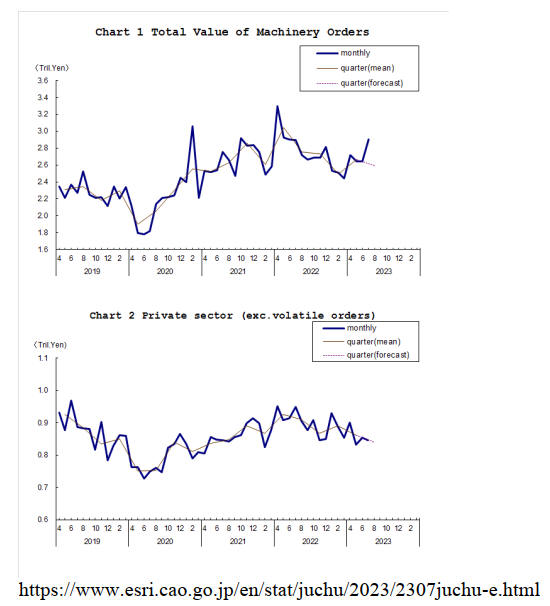
End of ulta-easing policy not far away
Early September comments from Bank of Japan Governor
(BoJ), Kazuo Ueda, to the effect that the end of the Bank’s
negative interest rate policy (NIRP) is not so far away,
resulted in the yen exchange rate becoming more volatile.
The yen had begun moving closer to the 150 mark but on
the comments from the BoJ the yen strengthened.
The local media have reported that the BoJ is waiting to
see if wages and prices rise before making a decision on
interest rates.
The finances of a wide range of industries including
automobiles and distribution have been improving due to
the depreciation of the yen and this was reflected in the
summer bonuses at major companies. Although an
increase in interest rates will be an extra burden on
households the thinking is that if the economy improves
companies will have the strength to absorb the increased
burden and keep price increases to a minimum .
The government is concerned that China's worsening
economy could undermine Japan's recovery, especially if
the government in China fails to implement extensive
stimulus measures to boost domestic demand. Under these
circumstances the Bank of Japan will be cautious about
shifting to a more ‘normal’ monetary policy. China's
economic downturn is undermining Japan's export
dependent economy.
See:https://www.dailyfx.com/news/japanese-yen-rallies-on-bank-of-japan-s-ueda-comments-will-usd-jpy-reverse-20230911.html
and
https://japannews.yomiuri.co.jp/business/economy/20230909-135602/
In early September, when announcing changes to the
Cabinet, the Japanese Prime Minister said he will soon
compile a package of "drastic" economic measures to
boost the country's fragile recovery. The aim, he said, is to
“protect the people's lives from burdensome price rises
and to reinforce the trend of wage increases and
investment expansion”.
In a move aimed to help struggling household finances the
Ministry of Agriculture said that it will lower domestic
sale prices of imported wheat by 11% on 1 October.
The weighted average price for five imported wheat
products for sale to domestic milling companies will drop
to 68,240 yen per tonne, on the back of plentiful harvests
in major production areas in the United States and falls in
ocean freight fees. This will be the first drop in three
years.
See:
https://www.nippon.com/en/news/yjj2023091200872/japan-to-lower-imported-wheat-prices-by-11-pct.html
Real wages decline foro a 16th consecutive month
Data from the Cabinet Office in Japan shows real wages
extended their decline for a 16th consecutive month in
July as salaries failed to keep up with rising prices.
Global financial markets closely follow wage trends in
Japan as the Bank of Japan emphasises sustainable wage
rises as a prerequisite for deciding whether and how to
reverse its ultra-loose monetary stimulus.
Inflation-adjusted real wages, a barometer of consumers'
purchasing power, slid 2.5% in July from a year earlier
following a 1.6% slump in the month before.
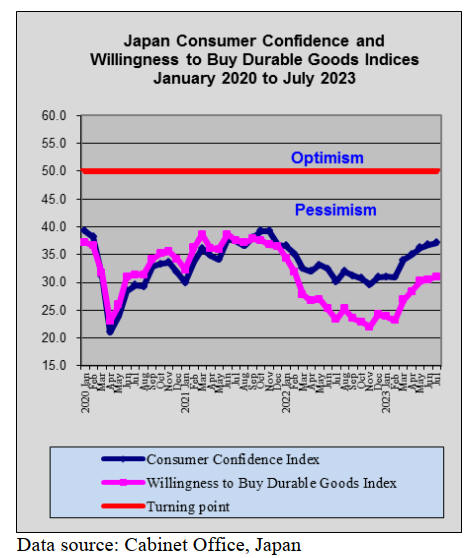
Hottest ever summer in 2023
According to the Japan Meteorological Agency the
country experienced its hottest ever summer in 2023. The
average temperature for the June to August summer
months was the highest on record.
Based on measurements at 15 observation stations across
the country temperatures were almost 2 degrees higher
than seen over the last three decades (1991–2020) and the
highest since statistics began in 1898.
Wood carbonisation technology rooted in tradition
Japanese technology has spread globally and some have
their roots in tradition. One such technology is the
production of cabonised wood (yakisugi) which involves
burning the surface of the timber to be used for exterior
construction.
The carbonisation process begins with the flaming of the
wood surface, brushing to remove excess charcoal, the
application of a waterproofing coating and finally a
coating of sealant. All of these conditions
make yakisugi treated wood extremely durable. Satoshi
Kimura, Operations Director at Japanese-based company
says wood treated in this way can last for 80-90
years when properly maintained.
See:
https://www.archdaily.com/880330/carbonized-wood-a-traditional-japanese-technique-that-has-conquered-the-world
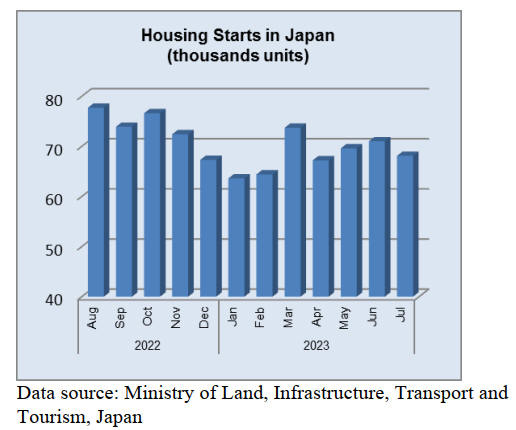
Yen moves on to Bank of Japan Governor comments
In early September the Japanese currency strengthened on
comments from the BoJ and at the same time the US dollar
gained as investors awaited inflation. At one point the US
dollar strengthened to 147.15 against the yen.
Analysts anticipate yen exchange rate volatility after
comments from Bank of Japan (BOJ) Governor Kazuo
Ueda heightened expectations the Bank could shift away
from its negative interest rate policy.
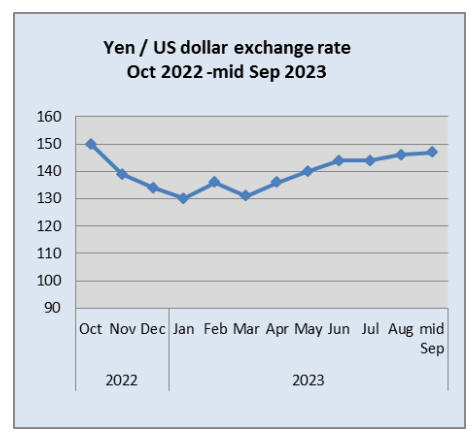
Import update
Assembled wooden flooring imports
July marked the third consecutive month when there was
an increase in the value of imports of assembled wooden
flooring (HS441871-79). This has brought the average
value of monthly imports almost back to levels seen in the
first half of the year.
Year on year, July imports of assembled wooden flooring
were down 9% but compared to June the value of imports
jumped 27%. Of the various categories of assembled
flooring imports in June, HS441875 was the largest
accounting for 66% of the total value of assembled
flooring imports followed by HS441879. The main
shippers of HS441875 in July were China 56% Malaysia
12% and Thailand and Indonesia around 6% each.

Plywood imports
July marked yet another month of declines in the volume
of imported plywood, a trend which began in mid-2022.
Year on year July 2023 plywood arrivals were 42% down
with all shippers seeing year on year declines in the value
of shipments. The volume of shipments from Malaysia and
Indonesia were down sharply. Compared to arrivals in
June import volumes were flat in July for each of the four
top suppliers.
A major Sarawak-based plywood exporter has forecast
that plywood export prices are likely to improve in the
second half of 2023 as Japan adjusts up its low plywood
inventory (see page 4).
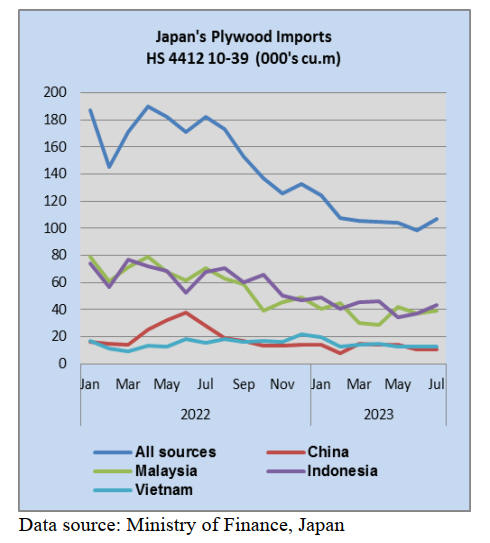
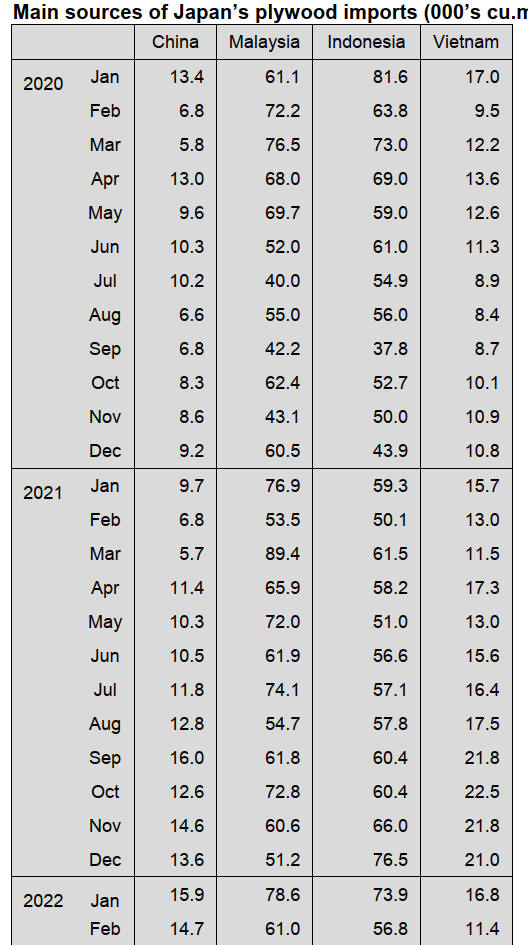 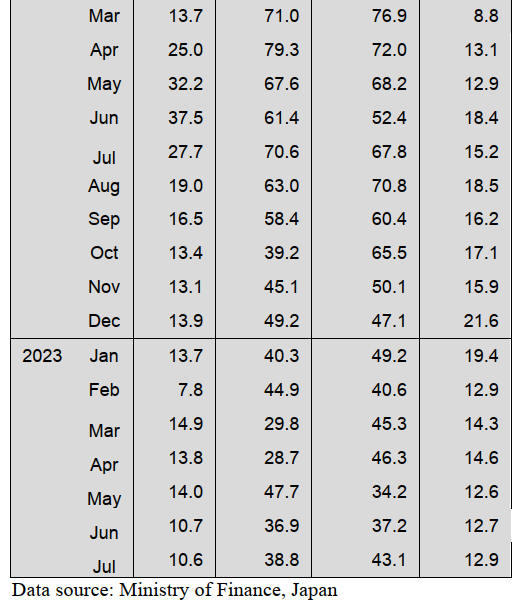
Trade news from the Japan Lumber Reports (JLR)
The Japan Lumber Reports (JLR), a subscription trade
journal published every two weeks in English, is
generously allowing the ITTO Tropical Timber Market
Report to reproduce news on the Japanese market
precisely as it appears in the JLR.
For the JLR report please see:
https://jfpj.jp/japan_lumber_reports/
Damage from torrential rain
Tohoku Regional Forest Office announces about damages
in national forests by the torrential rain in July. There are
23 places of devastation of forest land in Akita Prefecture
and the total damage is 1.1 billion yen. There is one place
damaged in Iwate Prefecture and the total damage is 30
million yen.
There are 562 forestry roads destroyed in Akita Prefecture
and the total damage is 1.7 billion yen. There are 27
forestry roads destroyed in Iwate Prefecture and the total
damage is 100 million yen. In Aomori Prefecture, 23
forestry roads are destroyed and the total damage is 31
million yen. There is one forestry road damaged in
Yamagata Prefecture and the total damage is 20 million
yen.
In Akita Prefecture, the total damage of devastation of
forest land of forest under private ownership is 13 billion
yen and of damaged forestry roads is 12 billion yen.
According to The Ministry of Agriculture, Forestry and
Fisheries, there are several kinds of support for
manufacturers which related to forestry business and
lumber business.
Forests owned by foreign capital
According to The Ministry of Agriculture, Forestry and
Fisheries, there are 14 cases of acquirement forest in Japan
by foreign capital in 2022. This is 5 cases less than 2021.
The forest area is 41 hectares, 190 hectares less than the
previous year. 90 % of 41 hectares is Hokkaido Prefecture.
The purpose of use is asset holding. There are other forests
acquired in Kanagawa, Niigata, Shizuoka, Kyoto and Nara
prefectures.
There are 4 acquisitors from China including Hong Kong,
3 acquisitors from Singapore, 2 acquisitors from Macao
and 2 acquisitors from the Virgin Islands. Total forest area
acquired during 2006 to 2022 is 2,732 hectares by 320
cases.
Wood product imports for the first half of 2023 for
China
Volume of logs during January to June, 2023 is 9.3 % less
than January to June, 2022. One of reasons is that Russia
banned exporting logs to overseas. On the other hand,
volume of lumber is 10.5 % more than the same period
last year. 1,000 cbms of all Russian logs are red pine logs
and the rest of all Russian logs is hardwood logs. There
are no more softwood logs imported China from Russia.
German logs are 10 % less than the first half of 2022.
Polish and Japanese logs increased from the same period
last year. NZ logs are 8.3 % increase from the same period
last year because storm and flood damages, which were
cause by a cyclone, have been influencing the log export.
However, the log export would rise after the situation in
NZ gets back to normal. Volume of lumber of many
countries exceed the results of January to June, 2022.
Especially, volume of lumber of Sweden and Belarus are
two times more than the same period last year.
Import of laminated structural lumber
Imported laminated structural lumber in January to June,
2023 is 281,012 cbms, 42.8 % less than January to June,
2022. This if for the first time in thirteen years to be under
300,000 cbms. The reason is that orders for laminated
structural lumber have been a small volume since last year
due to an excessive supply. Volume of laminated small
lumber such as laminated post decreases a lot from the
first half of 2022.
Laminated structural lumber from Finland is 130,713
cbms, 32.1 % down from the same period last year.
Laminated structural lumber from Romania is 38,156
cbms, 58.8 % down from the same period last year. Ther
reason for decline would be a reduction of product at
Radauti mill of HS Timber Group in Romania.
Austria declines by 49.4 %. Russia declines by 47.3 %.
China declines by 64.1 %.
Volume of Germany during January to June, 2022 was
23,815 cbms but volume of Germany during January to
June.
Domestic lumber and logs
Dull movement of domestic lumber in August influences
demand and supply of logs. The price of cedar post
reaches the bottom in northern part of Kanto region at the
end of July but the movement of domestic lumber changed
in August. The market price of KD cedar post in Kanto
region is around 55,000 – 60,000 yen, delivered per cbm.
Demand and supply of lumber, laminated lumber and
plywood are sluggish through the nation so a market tone
is low. The price of log with A sort for lumber and log
with B sort are not easy to be lowered.
The price of raw timber in northern part of Kanto region
declined to 10,000 yen, delivered per cbm during May and
June. In Ibaraki Prefecture and Fukushima Prefecture, the
log price was 8,000 yen. Then, there was a reduction of
raw timber and the log price started to rise in July and
August.
In Tochigi Prefecture, 3m cedar log was around 11,000 –
13,000 yen at the end of July. There is less raw timber in
Kyushu area due to the torrential rain at the beginning of
July. Some manufacturers from northern part of Kyushu
area, Kumamoto Prefecture and Miyazaki Prefecture
collected logs and once the market price of log became
strong. However, demand and supply are weak in places,
where had no damages of the torrential rain.
In Akita Prefecture, there was also a heavy rain and there
were damages on mountains and forests. However, there
are enough inventory of plywood and laminated lumber
and there is no effect for raw timer now.
Plywood
Movement of domestic softwood plywood in August was
not good. Since the price of domestic softwood plywood
reached the bottom in July, there had been orders to
trading companies and wholesalers. However, demand of
house is unclear in the future so movement of domestic
softwood plywood became slow after the summer holiday
in August.
Consumers purchase only a small amount to fill current
needs. 12 mm 3 x 6 structural softwood plywood is 1,600
yen, delivered per sheet and this is no change from last
month.
Plywood companies in Western and Easter Japan left
prices unchanged in August. Thus, several plywood
companies would raise the price in September because of
increasing fuel expenses, electricity bills and salaries.
Volume of imported plywood has been decreasing and
demand of imported plywood is not active after the
summer holiday ended in August.
2.4 mm 3 x 6 plywood in South Asia costs around $950,
C&F per cbm. 3.7plywood is $880, C&F per cbm. 5.2 mm
plywood is $850, C&F per cbm. Form plywood is $560,
C&F per cbm. Structural plywood is $560, C&F per cbm.
The market price of form plywood and structural plywood
is 1,800 yen, C&F per cbm. 2.5 mm plywood is 780 yen,
C&F per cbm. 4 mm plywood is 1,000 yen, C&F per cbm.
5.5 mm plywood is 1,200 yen, C&F per cbm.
The price of painted plywood for concrete form reaches
the bottom in South Asia. In July, shippers in South Asia
raised the price by $20 – 50, C&F per cbm, up from
previous time because there is a shortage of painted
plywood for concrete form in Japan. The price in South
Asia is $670, C&F per cbm. The price of 12 mm 3 x 6
form plywood in Japan is 1,950 yen, delivered per sheet.
Wood products import for the first half of 2023
According to The Japan Lumber Importers’ Association,
volume of imported lumber during January to June, 2023
is 4,438,000 cbms, 34 % less than the result of January to
June, 2023. This volume would not exceed the result of
1962. It was 9,310,000 cbms in 1962.
Imported log is 1,058,000 cbms, 26.7 % less than the same
period last year. This is because of a decrease in North
American log. Imported lumber is 1,692,000 cbms, 40.5 %
less than the same period last year. European lumber
decreases 43.5% from the first half of 2022. The
woodshock, which occurred in spring, 2021 started to
calm down in autumn, 2021.
However, volume of imported lumber at the first half of
2022 was massive volume because the lumber arrived to
Japan very late. Then, trading companies decreased a
number of orders for lumber at the second half of 2022.
Therefore, the volume of lumber at the first half of 2023
plunged. North American log and lumber are 29.8 %
down. European log and lumber are 43.4 % down.
There has been no record for Russian log because of
banned import and export between Russia and Japan.
There had been a small demand for South Sea log for
producing plywood. Since demand of domestic log for
crating increased, volume of NZ log decreased.
Laminated structural lumber is 281,000 cbms, 42.8 % less
than the first half of 2022. This decrease in laminated
structural lumber is linked to the decrease in North
American and European lumber. Plywood is 33 % less
than the same period last year.
|